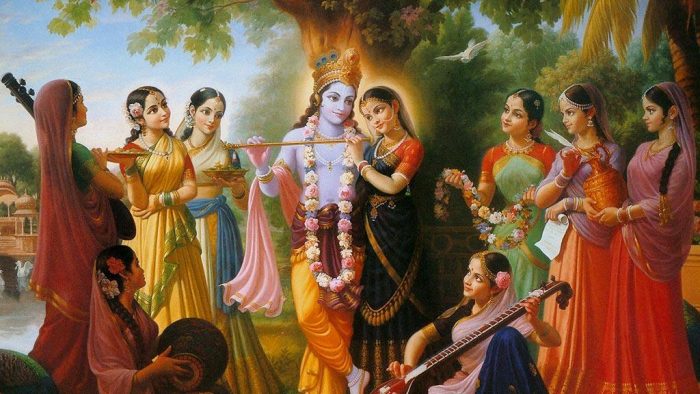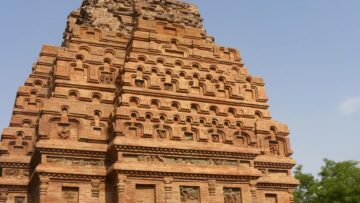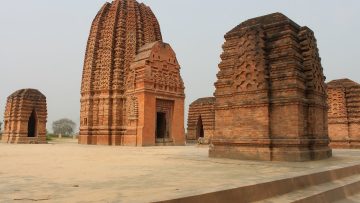Ayodhya Mathura Maya Kashi Kanchi Avantika
Puri Dvaravati caiva saptaita moksha dāyika
Ayodhya Ramanagari Mathura Krishnapālita
etas tu prithvī madhyae nagaṇyatae kadāchana
shriramadhanuragrastha Ayodhya sa mahāpuri
Mathura keshavotsriṣṭasudarshanavidhārita
“Ayodhya, Mathura, Maya (Haridwar), Kashi, Kanchi, Avantika (Ujjain), Puri, and Dwarka are the places which confer spiritual liberation. Ayodhya is the city of Ram, while Mathura is protected by Krishna. But these two are never reckoned as being on earth. For the great city of Ayodhya rests on Rama’s bow, while the city of Mathura is supported by the Sudarshan (discus) of Shri Krishna”
The fields are a verdant landscape of satiation, and monsoonal activity. The environment, cleansed off its summer weariness, is clear and rejuvenated, with a soft breeze that can be seen awakening the petal’d boughs of Krishna’s favorite Kadamba tree, as Braj gets dressed in its most splendid to greet its ārādhya, Bala Gopala.
The waves of the Yamuna unable to suppress their excitement are breaching the banks at Mathura, waiting for that hour in which they’ll be blessed with the darshan of Devakiputra, so that they can carry Him to His chosen childhood home of Gokul, to the bosom of Yashoda.

Stone relief depicting the birth of Shri Krishna, 11th century C.E., from Uttar Pradesh
Shravan, a holy month for Hindus, has just concluded, but the atmosphere remains festive, and full of fervor, as the euphoria which the bhūmi pūjan at Ramjanmabhoomi has generated, continues to radiate its joyous energy in the heart of every dhārmik.
This is an occasion which has served as an oasis of bliss, amidst the grimness which has enveloped this year, infusing in us a propitious vigor for the commencement of preparations, for the welcoming of our Kanhaiya in Braj.

Vasudeva carrying baby Krishna in a basket across the Yamuna, Circa 1st Century C.E.
Janmashtami or Krishnashtami, which falls on the eighth day of Krishna Paksha in the month of Bhadrapad of the Hindu calendar, is an abiding tradition which is celebrated with much warmth and zeal. It is the day Bhagwan Vishnu’s Krishna avatār took place in Mathura, as the eighth child of Devaki and Vasudeva, while they were held in confinement in the fortress of the evil Kansa, who had been foretold of his death at the hands of the eighth born of his sister Devaki.
People observe upavās on this day, with some undergoing a nirjala vrat, which they break with prasād, such as caraṇāmrit, after midnight rituals relating to the birth of laḍḍū Gopal. The next day of Janmashtami is celebrated as Nandotsava, as a way to mark the festivities which were held in Braj, and particularly in the house of Nanda and Yashoda, after Kanha’s arrival, when Gokulvāsis gather at their home for a glimpse of Nandagopal.
On this occasion, people indulge in festive cheer, celebrating the tradition by smearing each other with a mixture of dahi (even milk), haldi, chandan, and kesar or just curd and turmeric. Festivities in Braj conclude with the chaṭhī celebrations for Yashodanandan which are held on the sixth day after ashtami.
Although Janmashtami celebrations in all of Braj are an occasion to behold, those at Keshav Dev temple in the Krishna Janmasthan complex hold significance as this is the place which Krishna chose for his avataraṇ in this world.
The atmosphere at the shrine throughout the day of Janmashtami is soaked in spirituality and devotion. In the morning a pushpānjali is organized on the līlāmanch, while in the early hours of the evening a shobhāyatrā is taken out with much ceremonial piety.

Banke Bihari, Vrindavan
Fragrances, chimes, bhajans, and chants jostle for attention in the devotional atmosphere which sweeps Braj during this auspicious time. Evening rituals at the Keshav Dev temple begin with an invocation to Ganesh, and the Navagrahas, which are followed by the ritual abhiṣek of Krishna with milk, curd, ghee, sugar and honey after which the lord is attired in a gem-studded poshāk and seated on a silver aṣṭadal lotus as the chanting of mantras, and bells, rings in the air.

Keshav Dev Temple, Mathura
While we wait for His arrival let us take a pilgrimage to the land of Krishna – the lyrical, the devotional, the resilient Brajbhoomi, where He spent an idyllic childhood, as Yashoda’s naṭkhaṭ Kanha, Makhanchor, Bansidhara, and Nandagopal.

Ogee arches and balconies containing human figures, 2nd century B.C.E., found from the archeological excavation of Katra Keshavdeva. Now in Government Museum, Mathura
“The first detailed account of Krishna’s life story occurs in the Harivamsa, an appendix to the Mahabharata. This narrates Krishna’s birth, his life with Nanda and Yashoda in Vrindavana, and his conflict with his wicked uncle Kamsa. Puranas such as the Vishnu, Padma, Brahmavaivarta, and Bhagavata provide further details of Krishna’s life in Vrindavana. While the 12th century Gita Govinda of Jayadeva celebrates the love of Radha and Krishna”.
Harivansha Purana describes in vivid imagery the atmosphere at the time of Krishna’s avataraṇ.
देवक्यजनयद् विष्णुं यशोदा तां तु दारिकाम्।
मुहूर्तेअभिजिति प्राप्ते सार्धरात्रे विभूषिते।
In the midnight, at the auspicious time of Abhijit nakshatra, Devaki gave birth to Vishnu and Yashoda gave birth to a girl.
सागरा: समकम्पन्त चेलुश्च धरणीधरा:।
जज्वलुश्चाग्नय: शान्ता जायमाने जनार्दने।।
When Janardana (Krishna) was born, oceans swelled (with joy), mountains (Dharanidhara – Shesha – Nilakantha) swayed and the fires burned calmly.
शिवाश्च प्रवतुर्वाता: प्रशान्तमभवद् रज:।
ज्योतींष्यतिव्यकाशन्त जायमाने जनार्दने ।।
When Janardana was born, auspicious breezes blew gently, the dust settled and the planets and stars shone brightly.
अभिजिन्नाम नक्षत्रं जयन्ती नाम शर्वरी।
मुहूर्तो विजयो नाम यत्र जातो जनार्दन:।।
When Janadarana was born, the auspicious star was Abhijit. (due to the confluence with star rohiNi on the eighth day) the night was Jayanti and the moment was Vijaya.
अव्यक्त: शाश्वत: सूक्ष्मो हरिर्नारायण: प्रभु:।
जायमानो हि भगवान्नयनैर्मोहयन् प्रभु:।।
Lord Hari, Narayana is beyond perception (avyakta), eternal (shāshvata), and subtle (sūkshma). The lord, as he was born, enchanted all with his eyes.
अनाहता दुन्दुभयो देवानां प्राणदन् दिवि।
आकाशात् पुष्पवृष्टिं च ववर्ष त्रिदशेश्वर:।।
Without being played, the drums of devas began to sound in heaven. The lord of devas showered flowers from the sky.
गीर्भिर्मंगलयुक्ताभि: स्तुवन्तो मधुसूदनम्।
महर्षय: सगन्धर्वा उपतस्थु: सहाप्सरा:।।
The sages along with Gandharvas and apsaras arrived and praised the slayer of Madhu with auspicious hymns.
जायमाने ह्रषीकेशे प्रह्रष्टमभवज्जगत्।
इन्द्रश्च त्रिदशै: सार्धं तुष्टाव मधुसूदनम्।।
When Hrishikesha (Krishna) was born, the entire world was overjoyed. Indra, along with devas praised the slayer of Madhu.

Traditional Janmashtami bhog
Bhagavata Purana narrates the festivities and rejoicing that marked Kanha’s arrival at the home of Nanda and Yashoda in Gokul.
नन्दस्त्वात्मज उत्पन्ने जाताह्लादो महामना: ।
आहूय विप्रान् वेदज्ञान्स्नात: शुचिरलङ्कृत: ॥
वाचयित्वा स्वस्त्ययनं जातकर्मात्मजस्य वै ।
कारयामास विधिवत् पितृदेवार्चनं तथा
धेनूनां नियुते प्रादाद् विप्रेभ्य: समलङ्कृते ।
तिलाद्रीन्सप्त रत्नौघशातकौम्भाम्बरावृतान् ॥
कालेन स्नानशौचाभ्यां संस्कारैस्तपसेज्यया ।
शुध्यन्ति दानै: सन्तुष्टया द्रव्याण्यात्मात्मविद्यया ॥
सौमङ्गल्यगिरो विप्रा: सूतमागधवन्दिन: ।
गायकाश्च जगुर्नेदुर्भेर्यो दुन्दुभयो मुहु: ॥
व्रज: सम्मृष्टसंसिक्तद्वाराजिरगृहान्तर: ।
चित्रध्वजपताकास्रक्चैलपल्लवतोरणै: ॥
गावो वृषा वत्सतरा हरिद्रातैलरूषिता: ।
विचित्रधातुबर्हस्रग्वस्त्रकाञ्चनमालिन: ॥
महार्हवस्त्राभरणकञ्चुकोष्णीषभूषिता: ।
गोपा: समाययू राजन् नानोपायनपाणय: ॥
गोप्यश्चाकर्ण्य मुदिता यशोदाया: सुतोद्भवम् ।
आत्मानं भूषयांचक्रुर्वस्त्राकल्पाञ्जनादिभि: ॥
नवकुङ्कुमकिञ्जल्कमुखपङ्कजभूतय: ।
बलिभिस्त्वरितं जग्मु: पृथुश्रोण्यश्चलत्कुचा: ॥
गोप्य: सुमृष्टमणिकुण्डलनिष्ककण्ठ्य-
श्चित्राम्बरा: पथि शिखाच्युतमाल्यवर्षा: ।
नन्दालयं सवलया व्रजतीर्विरेजु-
र्व्यालोलकुण्डलपयोधरहारशोभा: ॥
ता आशिष: प्रयुञ्जानाश्चिरं पाहीति बालके ।
हरिद्राचूर्णतैलाद्भि: सिञ्चन्त्योऽजनमुज्जगु: ॥
अवाद्यन्त विचित्राणि वादित्राणि महोत्सवे ।
कृष्णे विश्वेश्वरेऽनन्ते नन्दस्य व्रजमागते ॥
गोपा: परस्परं हृष्टा दधिक्षीरघृताम्बुभि: ।
आसिञ्चन्तो विलिम्पन्तो नवनीतैश्च चिक्षिपु: ॥
नन्दो महामनास्तेभ्यो वासोऽलङ्कारगोधनम् ।
सूतमागधवन्दिभ्यो येऽन्ये विद्योपजीविन: ॥
तैस्तै: कामैरदीनात्मा यथोचितमपूजयत् ।
विष्णोराराधनार्थाय स्वपुत्रस्योदयाय च ॥
रोहिणी च महाभागा नन्दगोपाभिनन्दिता ।
व्यचरद् दिव्यवासस्रक्कण्ठाभरणभूषिता ॥
तत आरभ्य नन्दस्य व्रज: सर्वसमृद्धिमान् ।
हरेर्निवासात्मगुणै रमाक्रीडमभून्नृप ॥
Śukadeva Gosvāmī: Nanda Mahārāja was naturally very magnanimous, and when Lord Śrī Kṛṣṇa appeared as his son, he was overwhelmed by jubilation. Therefore, after bathing and purifying himself and dressing properly, he invited brāhmaṇas who knew how to recite Vedic mantras.
After having these qualified brāhmaṇas recite auspicious Vedic hymns, he arranged to have the Vedic birth ceremony celebrated for his newborn child according to the rules and regulations, and he also arranged for the worship of the demigods and forefathers.
Nanda Mahārāja gave two million cows, completely decorated with cloth and jewels, in charity to the brāhmaṇas. He also gave them seven hills of grain, covered with jewels, and with cloth decorated with golden embroidery
O King, by the passing of time, land and other material possessions are purified; by bathing, the body is purified; and by being cleansed, unclean things are purified. By purificatory ceremonies, birth is purified; by austerity, the senses are purified; and by worship and charity offered to the brāhmaṇas, material possessions are purified. By satisfaction, the mind is purified; and by self-realization, or Kṛṣṇa consciousness, the soul is purified.
The brāhmaṇas recited auspicious Vedic hymns, which purified the environment with their vibrations. The experts in reciting old histories like the Purāṇas, the experts in reciting the histories of royal families, and general reciters all of them chanted, while singers sang, and many kinds of musical instruments, like bherīs and dundubhis were played in accompaniment.
Vrajapura, the residence of Nanda Mahārāja, was fully decorated with varieties of festoons and flags, and in different places, gates were made with varieties of flower garlands, pieces of cloth, and mango leaves. The courtyards, the gates near the roads, and everything within the rooms of the houses were perfectly swept and washed with water.
The cows, the bulls and the calves were thoroughly smeared with a mixture of turmeric and oil, mixed with varieties of minerals. Their heads were bedecked with peacock feathers, and they were garlanded and covered with cloth and golden ornaments.
O King Parīkṣit, the cowherd men dressed very opulently, with valuable ornaments, and garments, such as coats and turbans. Decorated in this way, and carrying various presentations in their hands, they approached the house of Nanda Mahārāja.
Their lotuslike faces extraordinarily beautiful, being decorated with saffron, and newly grown kuṅkuma, the wives of the cowherd men hurried to the house of mother Yaśodā with presentations in their hands. Because of natural beauty, the wives had full hips and full breasts, which moved as they hurried along.
In the ears of the gopīs were brilliantly polished jeweled earrings, and from their necks hung metal lockets. Their hands were decorated with bangles, their dresses were of varied colors, and from their hair, flowers fell onto the street like showers. Thus while going to the house of Mahārāja Nanda, the gopīs, their earrings, breasts, and garlands moving, were brilliantly beautiful.
Offering blessings to the newborn child, Kṛṣṇa, the wives and daughters of the cowherd men said, “May You become the King of Vraja, and long maintain all its inhabitants.” They sprinkled a mixture of turmeric powder, oil, and water upon the birthless Supreme Lord, and offered their prayers.
Now that the all-pervading, unlimited Lord Kṛṣṇa, the master of the cosmic manifestation, had arrived within the estate of Mahārāja Nanda, various types of musical instruments resounded to celebrate the great festival.
In gladness, the cowherd men enjoyed the great festival by splashing one another’s bodies with a mixture of curd, condensed milk, butter, and water. They threw butter on one another and smeared it on one another’s bodies.
The great-minded Mahārāja Nanda gave clothing, ornaments, and cows in charity to the cowherd men in order to please Lord Viṣṇu, and thus he improved the condition of his own son in all respects. He distributed charity to the sūtas, the māgadhas, the vandīs, and men of all other professions, according to their educational qualifications, and satisfied everyone’s desires.
The most fortunate Rohiṇī, the mother of Baladeva, was honored by Nanda Mahārāja and Yaśodā, and thus she also dressed gorgeously and decorated herself with a necklace, a garland, and other ornaments. She was busy wandering here and there to receive the women who were guests at the festival.
O Mahārāja Parīkṣit, the home of Nanda Mahārāja is eternally the abode of the Supreme Personality of Godhead and His transcendental qualities and is therefore always naturally endowed with the opulence of all wealth. Yet beginning from Lord Kṛṣṇa’s appearance there, it became the place for the pastimes of the goddess of fortune.

A 5th century C.E. relief, in stone, from Deogarh, Uttar Pradesh, depicting Vasudeva and Devaki, with baby Krishna, before being taken away to Gokul
Geography and layout of Krishna’s Brajbhoomi
Geographically, this region can be divided into two main parts, the hilly terrain comprising of sites such as Govardhan, Barsana, Nandgaon, Charan Pahari, which are part of the Aravalli range, and ecologically vulnerable, and the plains along the Yamuna, with places like Mathura, Vrindavan, Gokul, Mahavan and others. Both the hilly sites and those in the plains hold religious and historical significance in the evolved cultural mosaic of Braj.
The Yamuna, which is the main river, divides this region into two parts, the east, and the west, with the hilly shrines lying towards its western and northwestern side. Some of the other streams and smaller rivers that irrigate the region are Arind, Jhirna, Patwaha, and Sengar.

Mathura in ancient times
Archaeological surveys reckon that much of the habitation in Braj is over ancient sites, and mounds. People of the present day, very likely, trace their paths over the same routes their ancestors once tread. The word ‘Vraj’ translates into pasture or grazing ground.
The region’s current surroundings and environment suggest that in the ancient past this region, which is even now adequately drained by myriad streams and rivers, with forests and wooded nooks embroidering its naturally rich tapestry, was not just an ideal enclave for wildlife, but also a fertile landscape for rearing domesticated animals, who found abundantly endowed meadows all around to graze on.
Besides the evidence provided by historical literature, the existence of several clusters of woods, in times past, is also suggested by the names still retained for such places in Braj; Mahavan, Kumudvan, Kamvan, Bahulavan, etc.
As per Ramayana’s Uttar Kand, Mathura, the nucleus of Brajkshetra was established by Shatrughan, the younger brother of Bhagwan Ram, after slaying the demon Lavanasura. Agni, Indra, and other devas, pleased at this victory, helped him craft a picturesque city out of what was the forest of Madhuvan.
“Let this picturesque and charming city of Madhu built by the celestials be my capital”. The celestials with a delighted heart said to the descendant of Raghu, “Thy desire shall be fulfilled, and forsooth shall the city be turned into a picturesque space under the name of Surasena. In this way, the fearlessness of the celestial host, taking the shape of a country, a beautiful and picturesque city was reared in twelve years. All the fields there were filled with crops, and Indra began to pour showers in due season. That city on the banks of the Yamuna appeared beautiful like the half-moon and was filled with yards, shops, streets, beautiful houses, men of four orders, and various articles of trade, interspersed with various excellent gardens, pleasure grounds, and prosperously filled with celestials and men, and merchants from various countries…”
Uttar Kand, Ramayan
“The plain of the Kurus, the (country of the) Matsyas, Panchalas, and Surasenakas, these (form), indeed, the country of the Brahmarshis”
Manusmriti
Brajbhoomi which formed part of the territory of the Surasenakas is described as one of the regions comprising the land of Brahmarishis.
From Puranic literature, we further get an idea of how Mathura would have looked like in the olden times. As per these accounts, Mathura resembled Ashtami ka Chandrama, with a moat around its edge, and huge walls to protect it against attacks from outside. Its gateways were beautifully embellished with toraṇas.
It was a prosperous and fertile region brimming with affluence and culture. Its environment was lush with grasslands and amply studded with dense forests. The city patronized aesthetics and art which was visible in its elegant buildings, well-kept gardens, and a flourishing arts scene. Its people had a pleasant disposition, soft speech, and were known to possess an indomitable spirit on the battlefield.

Vāsudeva-Krishna is shown lifting Govardhan parvat on a stone relief from Mathura dating to the Gupta era. Note the mottled sandstone used to sculpt a much popular scene from Nandagopala’s life in Gokul. Govardhan pooja which is held around Diwali is a tradition to mark this event in the life of Shri Krishna
Krishna in the epigraphy and iconography of Braj
Sometime in the past, this son of yours was born in the house of Vasudeva; hence the wise who know the truth will duly designate him as the glorious Vāsudeva son of Vasudeva.
Garga to Nanda in Shrimad Bhagavata, Dasham Skandha
Braj has always been an intrinsic part of our religious landscape. Worship of Vāsudeva was prevalent alongside that of Shiva, Saptamātrikās, Sūrya, Ganesha, Kārtikeya, and Durga. But the region was predominantly associated with Vaishnavism, and Vāsudeva-Krishna occupied the prime of place in the devotional order because of the region’s significance in the life, and as the setting for the many līlas of Shri Krishna. The myriad traditions and folklores of Braj capture the hearts and imaginations of the devotees as they get drawn to this culturally enriched expanse soaked in Bhaktiras.
Epigraphic evidence points to the fact that the worship of Krishna went beyond the borders of Brajbhoomi. The Heliodorus pillar at Besnagar, erected by the Greek ambassador Heliodorus, on a visit to the Shunga court, as a mark of devotion to Vāsudeva, beautifully attests to this fact. Besides this, the 2nd century B.C.E. Nagari inscription mentions a temple of Vāsudeva and indicates the prevalence of Krishna bhakti during that era. Similarly, 1st century C.E. Gosundi inscription records the construction of a pūja Shila prakāra by a Bhāgavatā who was also the performer of Ashwamedha.
These accounts speak of the immense devotion among people of ancient times for Vāsudeva-Krishna. So much so that the strength of their reverence influenced even those who came into contact with them, to turn into bhāgavatās.

Vishnu Vaikuntha Chaturmurti showing Vāsudeva Krishna as the central human figure, 4th-5th century, Mathura
Panini’s Ashtadhyayi explains the word Vāsudevaka, as one whose object of Bhakti is Vāsudeva. “Megasthenes states that the Sourasenoi who lived in the Mathura region worshipped Herakles, by which he must have meant Vāsudeva-Krishna, who was the Indian god bearing the closest resemblance to the Greek god Herakles”.

Vishnu Caturanana, using the attributes of Vāsudeva, with the addition of an aureole around the head (5th century CE)

The Vasu door jamb, dedicated to Vāsudeva, “in the reign of Sodasa”, Mathura
Worship of Vāsudeva-Krishna was also part of the Vrishni traditions in which pancha vira or five heroes of the Vrishni clan namely Sankarshana, Vāsudeva-Krishna, Pradyumna, Samba and Aniruddha were held in reverence by the people of Braj. An inscription, found at Mora, in Mathura district, refers to the installation of images of the five heroes by a woman named Tosha during the reign of Shodasa (1st century BCE-early 1st century CE).
Another image, possibly originally from Mora, inscribed on a door jamb, and belonging to the reign of Shodadsa, refers to a toraṇa (gateway) and vedika (railing) which formed part of a mahā-sthāna (large temple) of Vāsudeva.

Vāsudeva-Krishna, on a coin of Agathocles of Bactria, 180 B.C.E. This is “the earliest unambiguous image” of the deity.
Krishna in the poetry of Braj
During the medieval period when the bhakti movement was sweeping across northern India, the region of Braj saw the development of a melodious and romantic language called Brajbhasha. This language evolved out of Shaurseni Prakrit, and became the vehicle of expression for the saints and poets of the Bhakti movement; aṣṭachāp poets of the Bhakti movement, like Kumbhandas, Surdas, Krishnadas, Parmanandadas, who came from the milieu of Brajbhoomi, composed their devotional poetry on Shri Krishna, relating to his childhood, his gvāla gopāla days and his rās with the gopīs, in this sweet dialect.
Surdas’ poetic imagination is a lively canvas set to music, in which he visualizes Krishna through the various stages of his life from the youthful ‘Makhanchor’ in ‘Maiyya main nahin makhan khayo’,
मैया! मैं नहिं माखन खायो।
ख्याल परै ये सखा सबै मिलि मेरैं मुख लपटायो॥
देखि तुही छींके पर भाजन ऊंचे धरि लटकायो।
हौं जु कहत नान्हें कर अपने मैं कैसें करि पायो॥
मुख दधि पोंछि बुद्धि इक कीन्हीं दोना पीठि दुरायो।
डारि सांटि मुसुकाइ जशोदा स्यामहिं कंठ लगायो॥
बाल बिनोद मोद मन मोह्यो भक्ति प्राप दिखायो।
सूरदास जसुमति को यह सुख सिव बिरंचि नहिं पायो॥
to ‘Udho! Mohe Braj Bisrat Naahin’, in which the poet expresses the yearning of Krishna for Braj in these lines – Udho (Krishna sharing his longing for Braj with his friend Uddhav says ) “I cannot forget Braj, the halcyon moments spent in its sublime environment.
The joy experienced every morning on seeing Maa Yashoda and Nanda Baba. The roṭi, mākhan, and dahī which Maa Yashoda lovingly fed with her own hands. The gopīs, gvālas, and other sakhās in whose company the most blissful moments were spent, I cannot forget Braj”.
Surdasji concluding the poem says that the Brajvāsis with whom Krishna spent his happiest hours were indeed blessed.
ऊधो, मोहिं ब्रज बिसरत नाहीं।
बृंदावन गोकुल तन आवत सघन तृनन की छाहीं॥
प्रात समय माता जसुमति अरु नंद देखि सुख पावत।
माखन रोटी दह्यो सजायौ अति हित साथ खवावत॥
गोपी ग्वाल बाल संग खेलत सब दिन हंसत सिरात।
सूरदास, धनि धनि ब्रजबासी जिनसों हंसत ब्रजनाथ॥
Krishna in the musical traditions of Braj
From the time Bansidhara’s bansurī’s mellifluous notes first enchanted the puṇyabhūmi of Braj, music has remained intricately woven into the elemental culture of the region spawning rich, and varied traditions, in music. Surdasji used to set his padas or poetic compositions to the melody of the various rāgas in different meters like sorathā, harigītikā, pādakulika, and ullālā.
Devotional music like samājagāyana, and Nitya kīrtana, in the temples of Vāsudeva, ensured that the ancient musical styles have stayed alive even in the current cultural setting of Braj. Dhrupad, a musical genre, which is an important part of North Indian classical music, has its roots in the musical traditions of Braj, since ancient times.
“Dhrupad constitutes an integral and indispensable component within the musical liturgies of Vaishnava temples. As part of the musical worship, devotional Dhrupad is rendered to the present day before the deities in the temples. The presentation of the temple Dhrupad is bound by liturgical rules, and hence Dhrupad compositions take their fixed place within the ritual cycle. While the classical Dhrupad proceeded more and more towards extinction after the 17th century and had almost disappeared by the 20th century, the Dhrupad tradition of the Vaishnava temples remained fully unbroken throughout the centuries. Since all the constituents of the ritual service are invariable, the temple Dhrupad was never threatened by extinction. Aesthetic inclinations of a worldly audience and their changing musical preferences cannot affect the musical service in a temple liturgy, because temple music is directed at the divinity alone who is the sole listener. Therefore, Dhrupad has always retained a strong presence in Vraj, and especially in Vrindavan.”
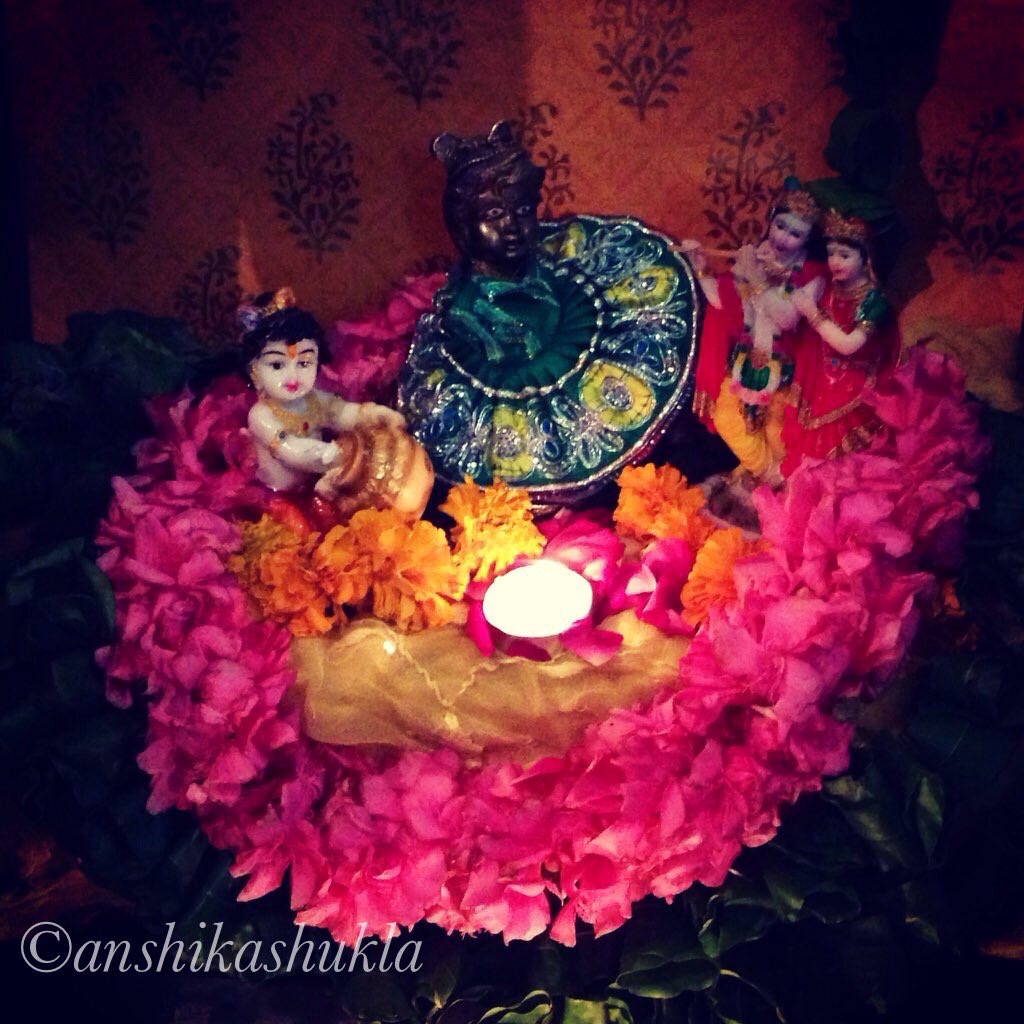
Janmashtami pūja at our place
Krishna in the art of Braj
Among the artistic traditions of Braj is the ancient dance form known as Charkula, in which veiled women rhythmically move around with a circular tiered structure balanced on their heads known as chārkula, which is lit up with many lamps or dīyas. The story behind the origin of this dance is associated with two events in the religious cultural history of Braj.
As per one, when Radha was born, her grandmother, unable to contain her feelings at this heartening news, ran out in jubilation, with a chārkula on her head, to announce the birth of her granddaughter. Since then this dance form is performed every year on Radha’s janmatithi, which falls a few days after Holi.
The second lore on the origins of the dance form relates it to the legend of Govardhan parvat, in which Krishna lifts Giriraj on his finger to provide shelter to Brajvāsis escaping the fury of Indra. The gopīs, relieved, and joyous, at Krishna’s victory perform a dance with chārkula on their heads in imitation of the Govardhan parvat, which Krishna had lifted to save their lives.
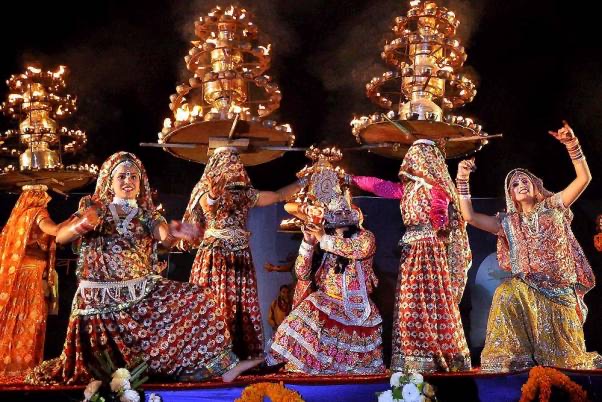
Charkula
Phoolbangla or the house of flowers is another beautiful age-old floral tradition of Braj, in which devotees make an elaborate arrangement with fragrant blossoms to provide relief to Krishna from the scorching summer heat. Banke Bihari temple is especially known for its ornate tradition of Phool Bangla.

Phoolbangla at Banke Bihari
Sānjhi or the folk art of Braj derives its name from ‘sānjh’ or evening, it is an ancient art form, traditionally created out of cow dung, and flowers, to form beautiful patterns on walls. It is said that Radha used to create Sānjhi at home in the evenings to evoke Shri Krishna’s presence. While Shri Krishna made Sānjhis with flowers to pacify a miffed Radha.
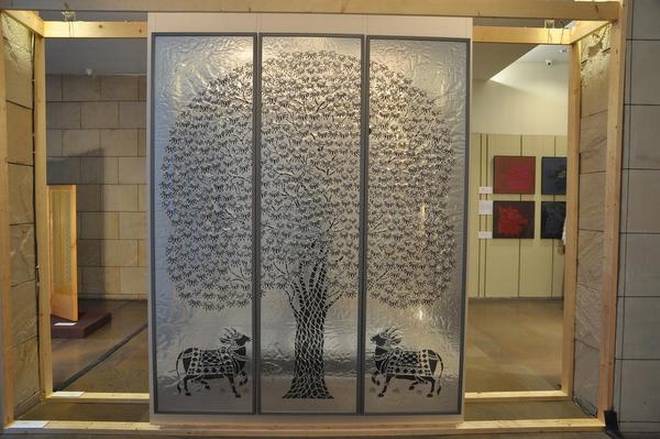
With time different materials have come into vogue for creating Sanjhis
Krishna in Hindu Philosophy – Devakiputra and Yashoda’s Kanhaiya as Jagat Guru
Shri Krishna‘s teachings to Arjuna on the battlefield of Kurukshetra, as the latter wrestled with multiple moral, and ethical dilemmas, before fighting the Dharmayuddha, is enshrined in the Veda-Vyasa krit Shrimad Bhagavad Gita and forms the essence of Hindu jīvan darshan. In this spiritual discourse between a bhakta and Bhagavān, Krishna navigates Arjuna out of the perturbations that daunt him, steering the chariot of life through the obstacles, and chaos, which mire it.
Krishna to Arjuna in the last chapter of Bhagavad Gita:
यदहङ्कारमाश्रित्य न योत्स्य इति मन्यसे |
मिथ्यैष व्यवसायस्ते प्रकृतिस्त्वां नियोक्ष्यति ||
If motivated by pride, you think, “I shall not fight,” your decision will be in vain. Your own material (Kshatriya) nature will compel you to fight.
ईश्वर: सर्वभूतानां हृद्देशेऽर्जुन तिष्ठति |
भ्रामयन्सर्वभूतानि यन्त्रारूढानि मायया
The Supreme Lord dwells in the hearts of all living beings, O Arjun. According to their karmas, he directs the wanderings of the souls.
अर्जुन उवाच –
नष्टो मोह: स्मृतिर्लब्धा त्वत्प्रसादान्मयाच्युत |
स्थितोऽस्मि गतसन्देह: करिष्ये वचनं तव
Arjuna to Bhagavān “O infallible one, by your grace my illusion has been dispelled, and I am situated in knowledge. I am now free from doubts, and I shall act according to your instructions”
Shri Krishna uvacha
अध्येष्यते च य इमं धर्म्यं संवादमावयो: |
ज्ञानयज्ञेन तेनाहमिष्ट: स्यामिति मे मति: ||
“And I proclaim that those who study this sacred dialogue of ours, will worship me (with their intellect) through the yajna of knowledge; such is my view”
Sanjay uvacha
यत्र योगेश्वरः कृष्णो यत्र पार्थो धनुर्धरः |
तत्र श्रीर्विजयो भूतिर्ध्रुवा नीतिर्मतिर्मम ||
Wherever there is Krishna, the Master of Yoga, wherever there is Partha, the archer, assured are glory, victory, prosperity, and righteousness, of this I (Sanjay) am certain
“Salutations to Krishna, the holder of jnānamudra, granter of desires of those who take refuge in Him, the milker of the Gita nectar, in whose hand is the cane for driving cows”
With these lines, I conclude our pilgrimage to Brajbhoomi on this auspicious occasion of Janmashtami.
Krishnam Vande Jagadgurum!
हाथी घोड़ा पालकी, जय कन्हैया लाल की,
आनंद उमंग भयो जय कन्हैया लाल की,
नंद के आनंद भयो जय यशोदा लाल की,
हे ब्रज में आनंद भयो जय यशोदा लाल की!!
References
- Shrimad Bhagavata Purana
- The Ramayana – Uttara Kand
- Harivamsa Purana
- Braj Ka Itihaas by Krishnadutt Vajpayee
- Shrimad Bhagawad Gita
- Poetry of Surdas
- Mahakavi Surdas by N. D. Bajpai
- Music and Fine Arts in the devotional traditions of India by Saurabh Goswami
- ध्रुपद संगीत का पारम्परिक केन्द्र वृन्दावन
- बृज की लोक चित्रकला साँझी
- A History of Ancient and Early Medieval India: From the Stone Age to the 12th Century by Upinder Singh
- The Life of Krishna in Indian Art by P. Banerjee
- Mirabai and her contributions to the Bhakti movement by S.M. Pandey
- Shabdakalpadrum by Raja Radhakantadeva
- ŚB 10.5.18
- tp://mahabharata-resources.org/harivamsa/vishnuparva/hv_2_004.html
- हरिवंश पुराण विष्णु पर्व (संस्कृत) अध्याय 4 श्लोक 21–25 – Krishnakosh
- https://www.bankeybihari.info/phool-bangala-gallery.html/
Disclaimer: The opinions expressed in this article belong to the author. Indic Today is neither responsible nor liable for the accuracy, completeness, suitability, or validity of any information in the article.

